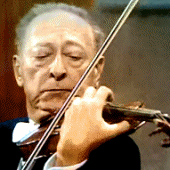![]()
| Roots and ethos of the Heifetz muse | |
|
Examples Intra-musical means of expression are, to my mind, elements that can be heard, regardless of whether one watches or not the performer. Tempo is just one such element. They are produced by mean of instrument manipulations, rather than other parts of the anatomy. They should not intrude onto the composition being played nor change its character, whatever that may be. Their employment is largely a question of taste which itself may change periodically with times and cultures (or with, as some would call it, fashions and tastes). Vibrato for instance, one of the most prominent violinistic ornaments, vary to a large extend according to performers, facility, period, etc. As a rule, its effectiveness, according to Auer, is proportional to its infrequent employment, i.e. too much usage detracts from its becharming qualities. This opinion was likely influenced by Joachim who is said to have almost detested the ornament and hardly, if ever, employed it (his two 1908 short recordings are somewhat inconclusive of that). As times changed, later violinists disproved the adage, i.e. Ysaỹe, Kreisler, Heifetz, Seidel, Elman, Menuhin, at all. The effectiveness of other ornamental qualities may also depend on the frequency and manner of their invocation. Portamenti, tempo oscillations and rubato, string changes for colour effects, different bowing techniques, are all effective ornaments - some written in the score, some left to the performer's imagination. Heifetz was a master of them all, not least of them the cantorial phrasing. (Phrasing, like rubato, is such an individual expressive asset that it is almost impossible to teach or impart.) The choking effect - An ornament employed by cantors to induce emotion, similar perhaps to a sobbing-chocked throat. Heifetz mimics this effect almost exclusively on the G-string by a split second de-synchronization between the bow stroke and the full string stop. That is, by starting the stroke a split second before the string is fully stopped against the fingerboard, a similar effect can be achieved on the fiddle to mimic the cantorial choke. Lest the following examples be considered a mild error of playing, it should be noted that these kind of ‘errors’ are absent in works where they are deemed to be inappropriate. portamento – An effect connecting two notes, where the finger slides from one note to the other. A portamento however, can also be a partial slide which doesn’t cover the whole interval between the two said notes. Heifetz employed this shift – unmarked in the score - liberally. Kreisler was another who employed the device, but the ‘Kreisler’ slide began with and from the start note, before landing on the target note with another finger. This is nowadays considered an ‘old-fashioned’ slide. In contrast Heifetz shifts first, before he lands somewhere short of the target note then rapidly slides right into it. (This was not always the case; in his recordings of youth one can hear a mixture of both types of slides, the ‘Kreisler’ and the Heifetzian ones, as the following short potpourri reveals: Lensky's aria was recorded in 1922). That his individual type of portamento reflected his genuinely personal expressive mode can be inferred from the fact that he often told students (who merely wished to imitate it) “Take out the slide, you don’t feel it!”. Also noted is the fact that the partial portamento as employed by Heifetz closely mimics some of the human voice shifts, in particular those from low to high notes1). If proof is needed that Heifetz’s style is in essence cantorial-vocalistic one, the following short examples make good. They reveal many of his cantorial qualities; "choking' effects, Heifetzian-cantorial slides, a unique rubato, the progressive incisiveness of bow attack (of which more later), etc.
1) This partial type of portamento toward the higher note mimics the action of the larynx, where muscles contract the vocal chords to produce a higher pitch. The muscular contraction action requires a certain amount of time to complete and if the sound production is deliberately started before the chords have reached the desired contraction, a rapid ascending voice slide can be heard. Much like the ‘Heifetz’ slide. |
|






